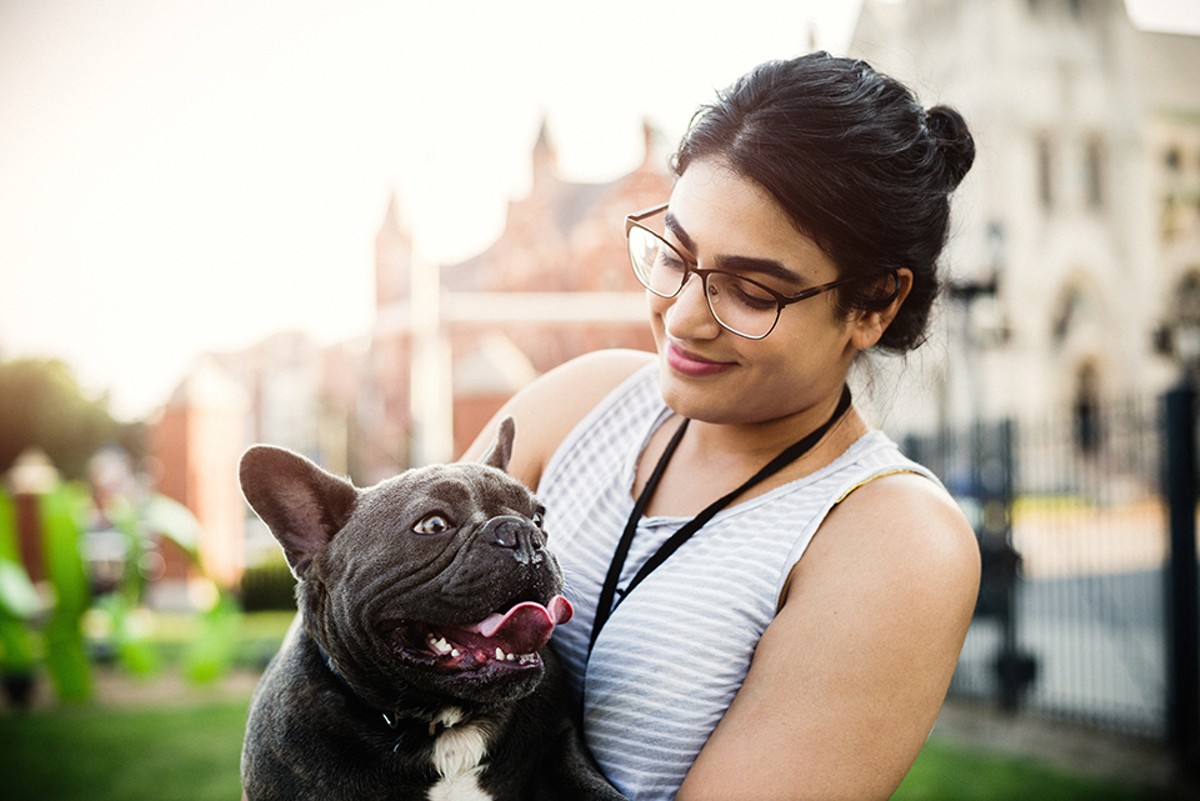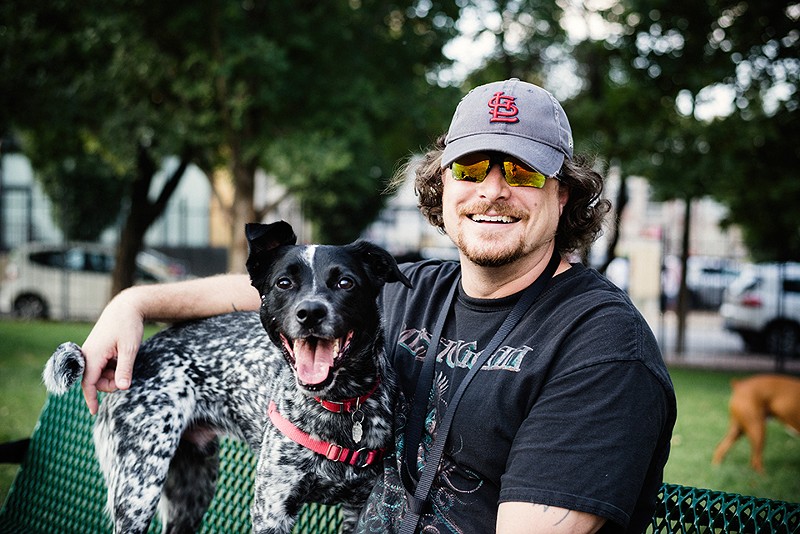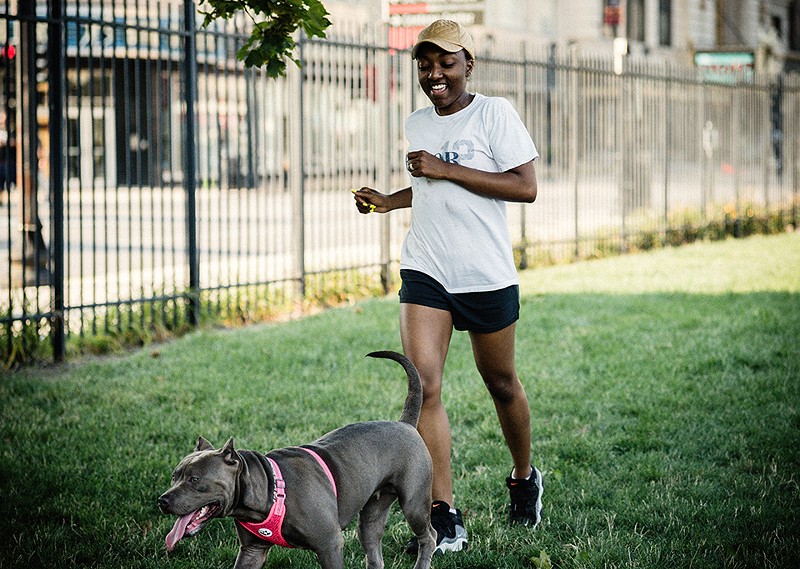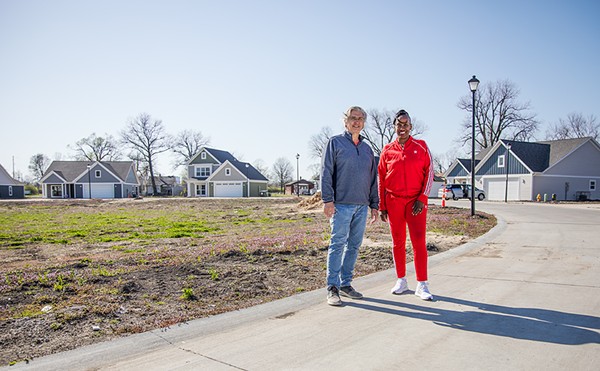Jon Porter has adopted a boxer mix named Rusty. More of a sidekick, really, Rusty is his constant companion on the weekends, when the two spend time at a few of St. Louis' most popular dog parks, including the unique situation that's cropped up on the corner of Lindell and North Grand boulevards. There, a green space called the Ellen Clark Sculpture Park has been a presence for the better part of a decade. If intended to be the quiet showcase of a prolific artist priest with ties to Saint Louis University, it's instead become an oasis for area dog owners, who flock to the space on the weekends, creating kinships that extend beyond SLU's signature black fencing.
As Porter describes it, the space isn't like any other in St. Louis — and he's not just talking about dog parks. Instead, as he sees it, the area is one that people use for a few different reasons. Proximity is part of it, of course, given the location within an easy drive of north and south city, as well as Highway 40. It is also free, saving users $50 to $100 in annual membership fees charged at other dog parks. And maybe there's just something about the location that calls out to people, with a little bit of an urban oasis vibe at any given moment.
Let's travel back to the weekend of July 4 as example. With temperatures in the hot zone, a dozen or so dog owners gather in the northeast corner of the park. Blessed as it may be by large-scale sculpture, the tree cover is minimal, and on a sunny day, the few park benches and single picnic table fill up quickly as dog owners huddle underneath trees and along the back fence line. They catch up on the day's news, updates in their personal lives and other bits of fractured conversation to go with quick bursts of dog behavior correction. The remnants of an Independence Day parade slow-roll down Lindell, with tiny pirate ships and apples and rocket ships passing down the block.
That might be the kind of thing you only see occasionally, but other sights are more frequent. Porter promises a vision of real diversity. Nursing students from campus gather in the early mornings before classes. Nearby apartment dwellers head in at the same time, or after work and at lunch. Visitors from other parts of the city arrive, mostly, in the happy-hour zone, when as many as 50 dogs have been seen in the summer. A 70-degree day in October can send even that number north. The owners are black, white, young, old, serious dog people and those who just want to tire out their animal.
Dana Abell is part of a group of friends who coalesced here, a self-dubbed Dog Pack. As happens with groups of young professionals, members come and go. The dozen or so who made up the group two years ago have dwindled to about half, with folks moving to all parts of the country. Those who remain still hang out, invite a person or two into the fold.
"We've all made connections here and network about things that aren't related to dog parks," she offers. "We know about your martial arts," she says, pointing at Porter. "And you can talk about things dog-related, like good vets or places that offer doggie pool days."
As she says this, her friend Mariah Greer pops back over to the picnic table. With two small dogs and a naturally high motor, she's zipping through the park, keeping track of her dogs, who've both been known to slip the fence for quick runs into Grand Center. Hearing some of the talk of diversity, she jokes, "I wouldn't hang out with this many white people without this dog park."
"We're bridging communities," Porter says sincerely of the dog community, though SLU would necessarily get some of that shine, as well. Mind you, none of this was part of a plan.
Former Saint Louis University president Lawrence Biondi is generally lauded for the positive impact he made on the built environment of the school's midtown Frost Campus, but there's an undercurrent of criticism attached to that legacy. Specifically, that for all the positives, there was a needless, heedless use of the wrecking ball in his tenure, and that instead of mothballing structures for later use there was a preference for permanent green space, be that used for statuary, playing fields or fountains.
The footprint that contains the Ellen Clark Sculpture Park provides an example for those who are critical, in that a building with multiple commercial uses and a street-facing presence was taken down for the added green space that was a hallmark of SLU expansion in the 1990s and 2000s. If cities are built by intersecting grids of streetside buildings, this corner is one more glitch in the matrix.
SLU's communications department notes, "SLU purchased the Marina Building, which was on the [northeast] corner of Lindell and Grand, in 2001. At the time, the building's occupants were the Golden Dynasty Restaurant, an optometrist, uniform company, beauty college and bar. After the building was removed, open space was created in 2011, which was imaginatively turned into a dog park and sculpture garden. Form meets function."
Construction began in 2010, with a blog/blogger named stlexplorer noting that a de facto dog park had already started to coalesce. On December 15 of that year, stlexplorer noted, "This lot has been informally used as a dog park for several years and I am glad to see it made into a more attractive place. Although I am disappointed to see a permanent use for the land that doesn't add to the density of the neighborhood, the fact that something is happening is a relief."
The construction there was about a decade in the making. Saint Louis University's campus newspaper, The University News, noted on July 11, 2001, that "this summer SLU purchased the Marina building at the corner of Grand Boulevard and Lindell Boulevard and the adjacent Feathers building at 3557 Lindell. While the Marina building was nearly vacant, the Feathers building is home to Vito's Pizza and 17 apartments. These property acquisitions come after the purchase of a vacant Jack in the Box at the corner of Grand and Olive Street, giving SLU control over the block at the entrance to Grand Center."
Kathleen Brady, cited as the vice president for facilities management and civic affairs at SLU, was quoted as saying the purchase of the Marina and the neighboring Feathers Building was possibly part of a more urbanistic future for the northeast corner of Lindell and Grand.
Brady, in the piece, added that SLU's goal, along with that of Grand Center, was to develop the property for a variety of uses, such as retail, restaurants, housing and possibly commercial office space. "This will benefit the University by bringing life and vitality to that corner of campus and providing more retail, restaurant and housing opportunities for students, faculty and staff," Brady explained. "By investing and improving the Grand Center area, the entire University community benefits from increased housing, retail and dining opportunities and from the stabilization of that area.'"
It was a good goal. But it changed.
The addition of a sculpture park at the crossroads of SLU and Grand Center can be understood within the broader landscape of the area; after all, Grand Center has long been building (or at least branding) itself as the hub of artistic energy in St. Louis. That this particular real estate has been given over to the works of Brother Mel Meyer, on one of the busier intersections in St. Louis City, makes sense in that context.
Tucked away in other, less visible outposts of the city are smaller oases of dog culture, including a wooded corner of Soulard known as the Frenchtown Dog Park. Run by an association of the same name, Frenchtown is a membership dog park. While a few members travel some distance, a larger group live in the immediate neighborhood, walking their dogs along the cobblestone sidewalks of Soulard for some shaded respite.
On a recent Saturday morning, Kalyn Niehoff is chilling with her energetic two-year-old dog, Lou. In search of a good chase, Lou darts among the three other dogs in the park without much luck. This sends him scampering hither and yon in search of fun in the larger of two zones, fitting in that it's the designated home of larger dogs. Even with a hot summer morning developing, the tree canopy keeps the temps down a bit as nearby Interstate 55 offers the morning's soundtrack, a steady buzz of traffic passing a couple dozen yards down the hillside.
Niehoff is likely correct in guessing that no homeowner would want that traffic noise so close. But for a group of dog owners and their wards, it's perfect. Over time, the Frenchtown Association, a fees-based group, has added shelters, various bits of "dog playground" elements and other amenities like running water. Dogs run, conversations are held.
"It's a great place to get advice for your dog, too," Niehoff says. "Like chewing behaviors. I've asked other people about leashes, because Lou likes to pull. It's a great place to get information about how to make your life with a dog easier."
"Easier" is a term that doesn't always apply to the arrival of dog parks in urban areas. St. Louis isn't a unique entity among cities, but something our urban center does have is space. Pocket parks of this sort have popped up in different areas without needing to displace. Even so, gentrification is a term that gets bandied about with the arrival of any new park.
Even a cursory web search of "dog parks gentrification" leads to some similar themes being discussed in various American cities. A lot of those articles point back to a story on CityLab from August 11, 2017. The story, by CityLab staffer Laura Bliss, sketches out a variety of debate points in relation to dog parks nationally.
"Resistance to dog parks," it reads, in part, "takes on a different tenor when animals seem to displace humans in housing-crunched cities. New dog owners are disproportionately younger and whiter than the residents of the cities they move into, and that has real estate implications: For one third of Americans aged 18 to 36 who'd purchased a first home, finding better space for a dog was the primary motivator, according to a SunTrust Mortgage poll. When young, white, affluent dog owners snap up properties in historically lower-income neighborhoods of color — and start advocating for amenities like dog parks, which can bump up property values further — the optics are complicated."
In St. Louis, those optics are different, as parks have taken over empty lots or off-the-beaten-path locations. And the dog-walker community here is so much smaller; unliked other cities, there typically aren't pros walking a Medusa-like batch of eight leashed animals into dog parks. The ratio feels closer to one-to-one. If there's a dark cloud of development needs in St. Louis, the sliver of a silver lining is the ability to use spaces for new and alternative uses.
There is a generational component that seems to run along with the conversation as well. At Frenchtown, the dogs vary in age, but their owners seem locked in a fixed age range of 25 to 35. Again, these are optics, but it's a younger crowd there. The park's litter bins are filled to the brim with spent cans of Natty Light and leftover packets, signs of price-conscious good times.
"Market research shows dog ownership has skyrocketed some 29 percent nationwide in the past decade," the CityLab piece continues, "an increase propelled largely by higher-income millennials. As young adult professionals increasingly put off having families, dogs have become 'starter children,' as Joshua Stephens wrote in The Atlantic in 2015. With demand growing, cities and developers are building more dog-friendly zones both in response to and in anticipation of more four-legged residents. Off-leash dog parks are growing faster than any other type of park in America's largest cities, with 2,200 counted as of 2010."
On this morning, even a non-dog walker can understand the appeal. As a breeze gently blows through the heavily canopied Frenchtown, a few dogs scamper, a few people share a casual greeting.
One member of the big dogs play group bounds straight up a tree for a longer-than-expected run in pursuit of a squirrel. "That was cool," Niehoff says. "I've never seen that happen." And she's spent a good deal of time here. "The doggy pool and shade allow people to hang out longer. I have friends in the area, and we'll meet here at the dog park, catch up, and the dogs get to play."
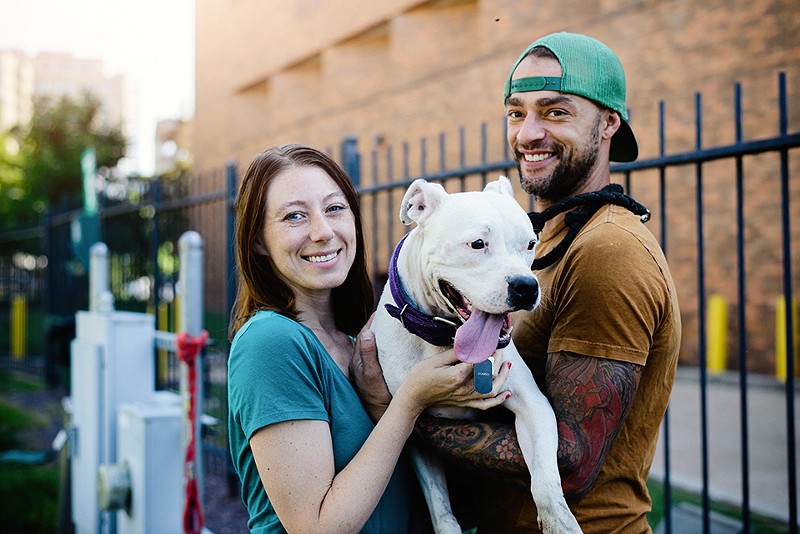
Frenchtown's presence in Soulard makes sense. If there was ever a zone of town that represented that blend of dog/person/hangout culture, it's Soulard. Spots like the old version of Molly's (itself named after a dog) and the Shanti were ahead of any trends in allowing four-legged visitors. That the Doghaus Soulard is found in this neighborhood — well, it more than makes sense.
Stephen Walters is part of a four-person ownership group at Doghaus, which took on the former location of Trop's and, before then, Gladstone's. They opened at Mardi Gras this spring, an experience that Walters says, with only a pained laugh, allowed them to work out some operational kinks under extreme conditions. Since then: smoother sailing.
He says that "we're a regular old bar that allows animals. If you want to use the dog park, there's a day pass and you sign an electronic waiver. There's a fee of $10 a day, and that's good all day, since a lot of people in Soulard bounced around. The other option is a membership, and you just need hard copies of your shot records. You get a tag for the dog's collar, and that's good for a calendar year and allows you to come and go as you please."
Walters says that "even though we started out as a neighborhood bar, we've got dog park members from Earth City, Fenton. Alton, Carbondale. That's been crazy, nuts. A lot of people are regulars and members, and it's become a great place for members to socialize. The social aspect behind it's been awesome and not just for the animals. I've had a couple people tell me that 'things are getting pretty serious with this girl, or this guy, and we met here.' That's cool. We wanna provide a place for people to do their thing."
And sometimes they connect more deeply, "even though we're not a dating service."
On a recent weekend afternoon, a brick building just to the south of the Doghaus' two fenced-in play yards allows for a little bit of shade. So that's just where Dayna Drennan and Dana Abell huddle as their combined three dogs play with a handful of others on a burner of a Saturday.
Part of SLU's Dog Pack, the Da(y)nas enjoy the Doghaus for exactly what it provides its members. As Drennan says, "It functions as a bar and a restaurant. That's kinda nice, because there might be a night when you wanna talk to a friend or significant other and you haven't given your dog the attention it needs. It's nice to do both."
And there's at least some code of conduct at play here. As dogs zip across astroturf and flop in and out of a wading pool, Drennan notes that "SLU can be a little less responsible than a place like this. There's accountability here. If your dog's a real dick, you can't come back. And I've stepped in a lotta poop at SLU over the years."
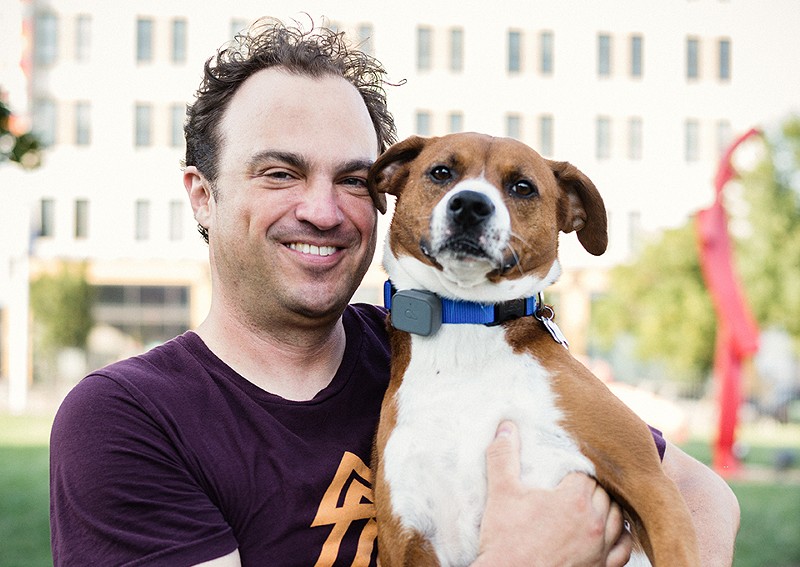
As dogs scamper through the Ellen Clark Sculpture Garden, they're shooting in and around the works of a Marianist priest known as Brother Mel, whose pieces number just more than a dozen in this park, and thousands in total.
Upon his passing at age 85 in October 2013, the St. Louis Post-Dispatch noted that "Brother Melvin Meyer once estimated that he had created more than 10,000 pieces of art during his 45-year career. He made large, colorful abstract metal sculptures; stained glass; watercolors; paintings; and handmade paper. St. Louis residents are familiar with Brother Mel's art. It seems to be everywhere in the region — in Forest Park, in hospitals, office buildings and chapels; throughout the campus of St. Louis University, and in hundreds of homes and backyards here and across the country."
Keeping the park intact as a dual-use facility is the job of the college's custodial and grounds services department, headed by popular SLU employee Jeff Macko. For a while now, SLU's de facto dog park has a been a place that's existed in a funny half-life. Being closed for several days a week and several months a year means offers and opportunity to keep the natural carpet of grass alive and thriving.
"We have a warm-season grass in there," Macko says. "It's primarily Bermuda, and that doesn't do well with heavy traffic when it's dormant and wet in winter months. That's why we shut it down. We've tried overseeding a little bit lately, which helps somewhat, but for us to keep it to the standards of where it fits in with the overall university grounds, we schedule a rest for that space."
Macko says he's unaware of another park of this sort.
"This is a sculpture park that's morphed into a place where people bring their dogs," he says. "I'm not aware of anything else necessarily like this at another university or school. Maybe there are. But yeah, this is a park that started out as a place to put Brother Mel's art, and it's turned into what we have here today."
And what they have today is a place that people want to enjoy, for free. The caveat here is that the park is open from Thursday to Sunday, 24 hours a day. It's shuttered the rest of the week, though determined dog parkers know just where to jump or shimmy through the fence line. It's also closed during the winter, from December 15 to March 15, a situation that causes no amount of consternation among the multi-hued diehards that inhabit this space the rest of the year. Some are more philosophical than others.
"We're really appreciative of what SLU does," Greer, an effervescent sort, offers.
Even if the hours are partial, the effects of this underrated slice of city real estate might be more lasting than the preconceived notion of what a dog park is all about.
Porter, a self-described introvert, is an active voice at the SLU park, meeting and greeting anyone he doesn't know, making introductions between newbies and regulars. Generally, he tries to ensure it stays a welcoming place. If the group that inhabits the park feels pretty good about itself for diversifying their hangout zone, well, they may deserve the praise.
"There's more diversity and more interaction that takes place than any other example I can come up with right now," Porter says. "People here have changed minds, interacted in ways you wouldn't think they would."

